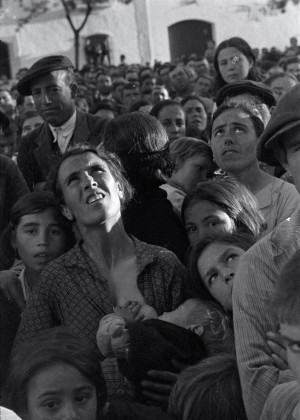David “Chim” Seymour – The Invisible Man
And yet, there are moments caught that transcend a particular face, such as a circle of workers bent over their meal, caught in a beam of light within their Vatican shelter. It’s an almost sacred ritual that greets us, like a stable gathering around none other than the Christ child. Another equally heart-stopping image is Citizens in an air raid shelter, Minorca, from 1938. A small group of villagers are caught huddling inside a Spanish stronghold in the Balearic Isles. Shooting into the shelter opening, the subjects are frozen in the center of his composition, caught in a pool of light at the end of their cave tunnel.
These images bring to mind the Magnum photographer Sergio Larrain’s quote that “a good image is created by a state of grace.” Can Chim be faulted for attempting an artistic formalism in the midst of recording a war? His early art school training and an unerring eye gave him an advantage over many point-and-shoot photographers, and separates him from the merely good. What’s to forgive, then, if art shares the spotlight with truth?
Children held a special place in Chim’s life obsession. And it’s evident in shot after shot that they held no fear of him. They became willing collaborators, sharing their innocence and world-weariness in equal measure. After the war, he returned to Europe to document the plight of these orphans for the recently formed UNICEF (United Nations International Children’s Emergency Fund). Paid $2,600 for a three-month stint, he roamed over Austria, Greece, Hungary, Italy and Poland, filling 257 rolls of film.
These stirring portraits tell us volumes at a glance: A little girl holding two dolls at a refugee center in Barcelona; another, Children Playing on Omaha Beach from 1947, one of the few color photographs on exhibit, features a group of children frolicking in the sand under an abandoned warship that sits like a gray beached whale on the landscape. In another, a tiny white-haired tot surveys Essen’s vast rubble of ruin from a burnt-out building. A wide shot of a war torn city square leads the eye to a pair of orphans, no more than three or four, holding hands as they stroll — seemingly unnoticed by older passersby, in their new post-apocalyptic world.
Curtis Bill Pepper, a journalist colleague from Rome, had this to say in We Went Back about the mystery behind Chim’s special relationship with children: “Chim came in and out of our lives unexpectedly, like a sunrise. He extended our inner lives with his feelings. This corresponds with his affinity for children in his photography. We all have children inside us, the residual element of wonder that is never extinguished, and this is the part he was talking to.”
By the ’50s, Chim enjoyed the friendship of a colorful network of celebrities — Ingrid Bergman with her newborn twin daughters is one of the delights of this section of the exhibit. Sophia Loren, Truman Capote, and a clowning Fred Astaire add a lighter element. Bergman in particular was a close friend, remarking to him that “you are a marvelous photographer and I am a marvelous baby-maker.” He was never an intruder to such personalities but an invited guest. If he was the invisible man, the aura he exuded wherever he went was a warm one.
Visitors will not easily find a wealth of diary entries or casual commentary by the artist to aid in unraveling his genius. It’s all in the images themselves, images that sear themselves on the brain, slow or impossible to evaporate from our consciousness. The impetus to mount such a comprehensive exhibit, encompassing over 120 vintage black-and-white and color prints came from the arrival in 2007 of what curator Young dubs “the Mexican suitcase.” Filled with a score of negatives, this alone was cause enough to re-evaluate the artist’s contribution. (In 1939, recognizing the escalating dangers of remaining in Europe, Chim had escaped Spain in a sailing vessel bound for Mexico. In 1942, he became a naturalized U.S. citizen under the name of David Seymour.)
One of the most touching remembrances in the catalog is journalist Bill Bradlee’s. He could still see Chim, “a wisp of a man,” standing atop his jeep, “silhouetted against the darkling sky, quickly photographing mob scenes of Egyptians in the ruined city of Port Said. Two hours later, he was dead.”
The last thing he wrote to his Magnum friends was telling for a man of such fortitude and fearlessness: “I would like to be into things.” Chim the photographer and the man certainly managed to do that, and as a result the world is so much richer for it.
(“We Went Back: Photographs from Europe 1933-1956 by Chim,” is on view at the International Center of Photography, located at 1133 Avenue of the Americas at 43rd Street, New York, NY through May 5, 2013. For more information, please call 212-857-0000 or visit www.icp.org.)

Featured photo: Chim, [“Woman nursing a baby at a land reform meeting, near Badajoz, Extremadura, Spain”], April– May 1936. © Chim (David Seymour)/ Magnum Photos.

